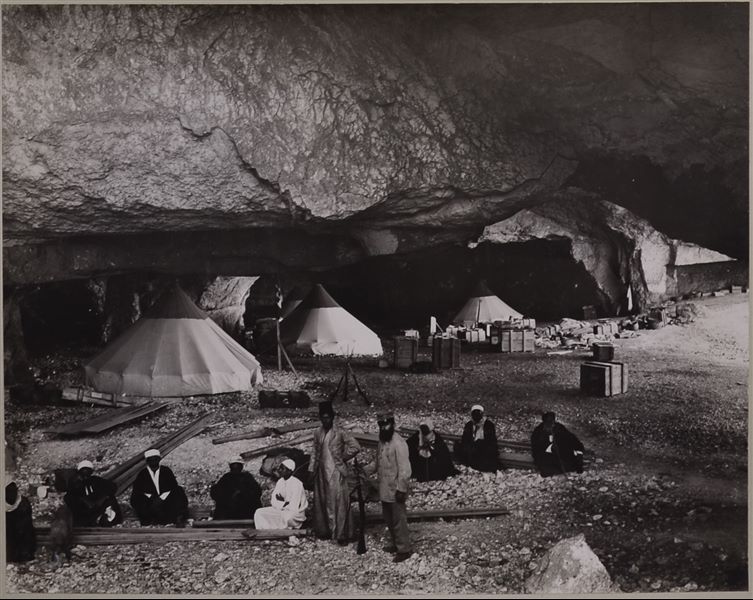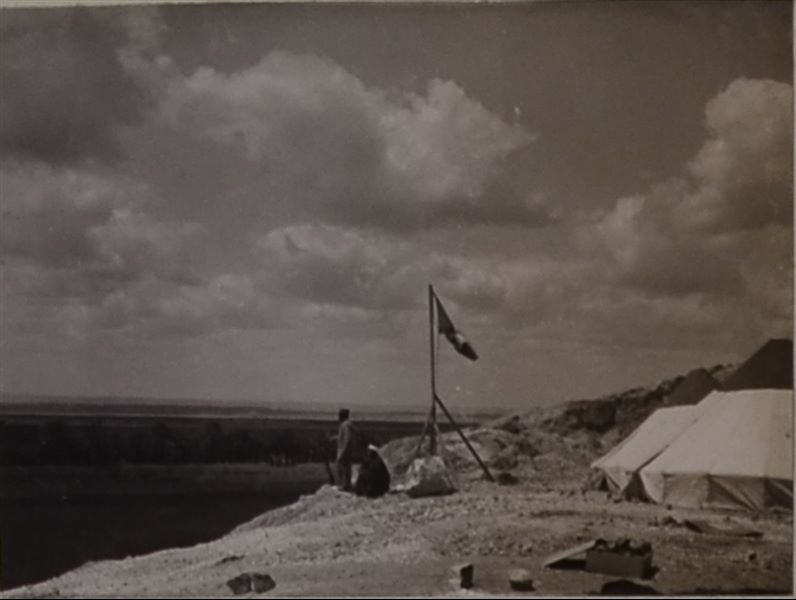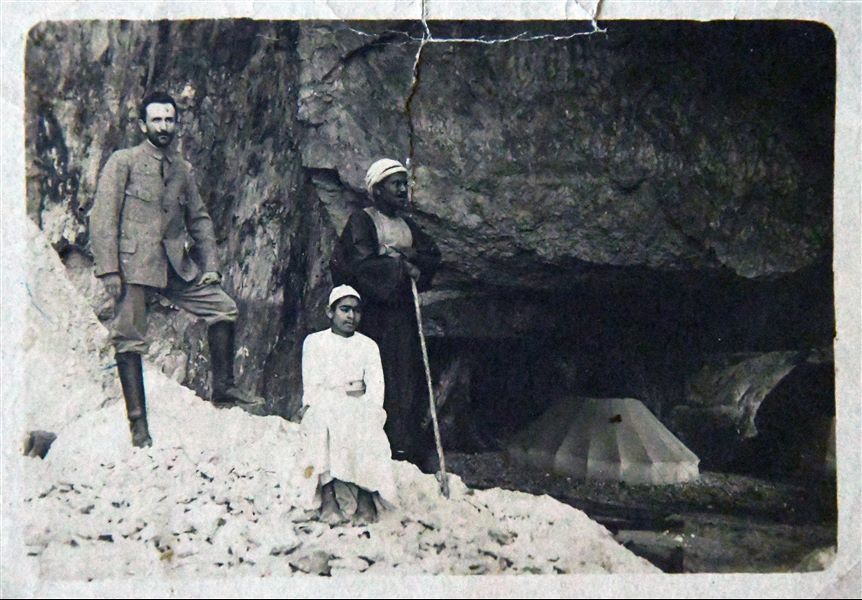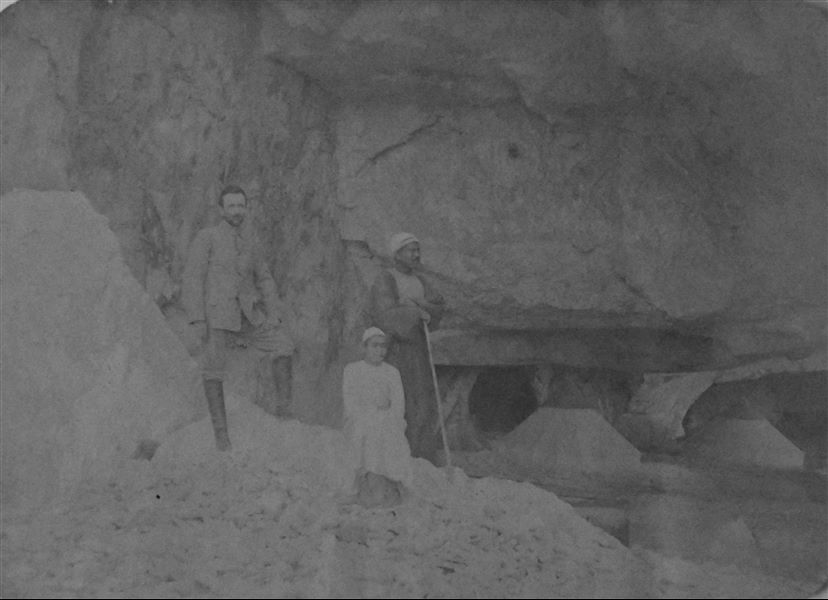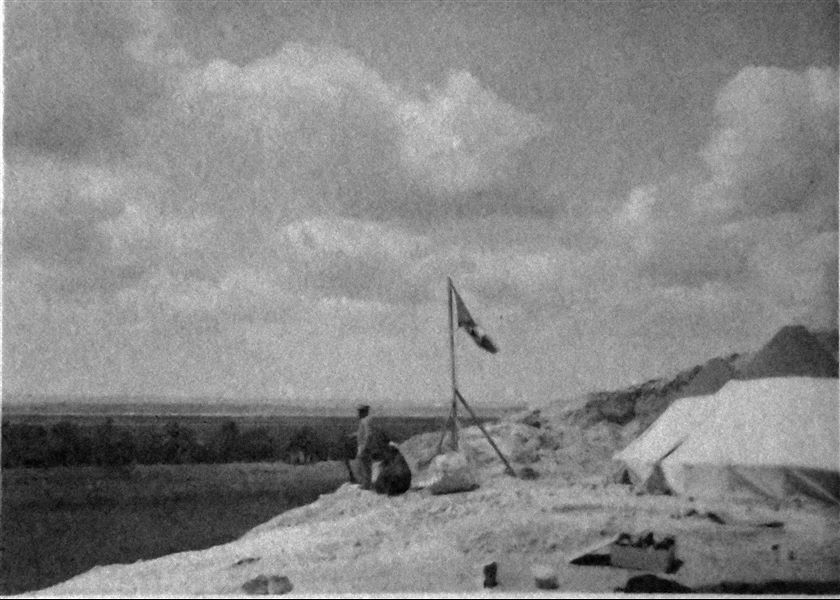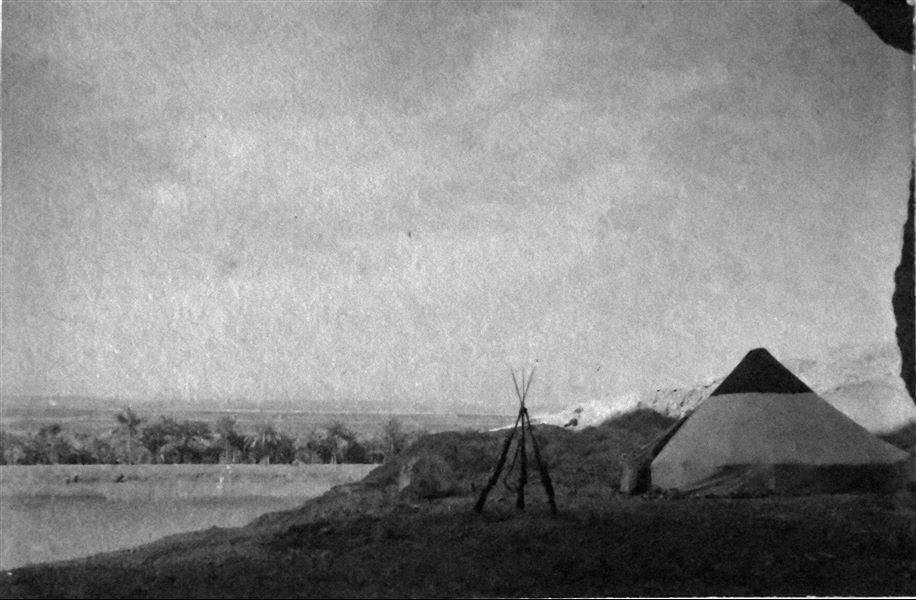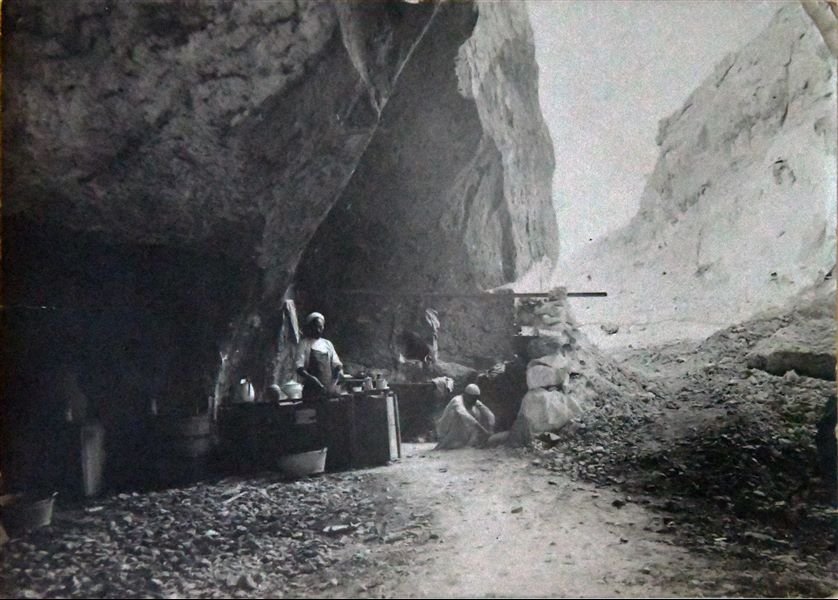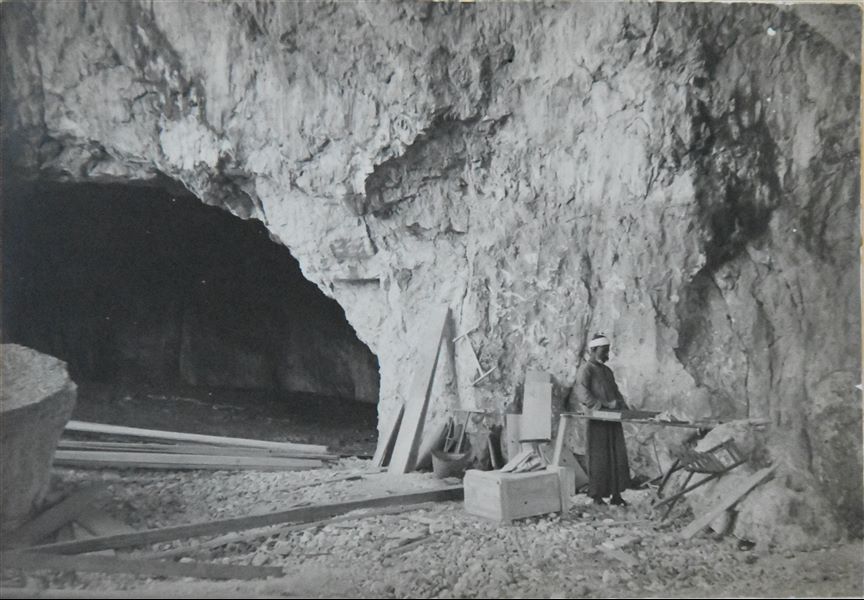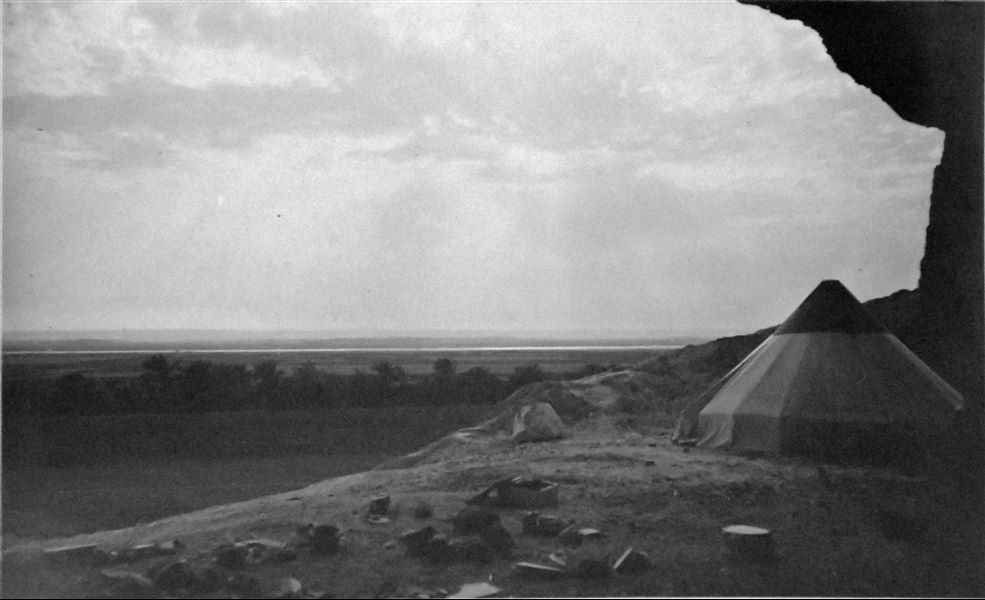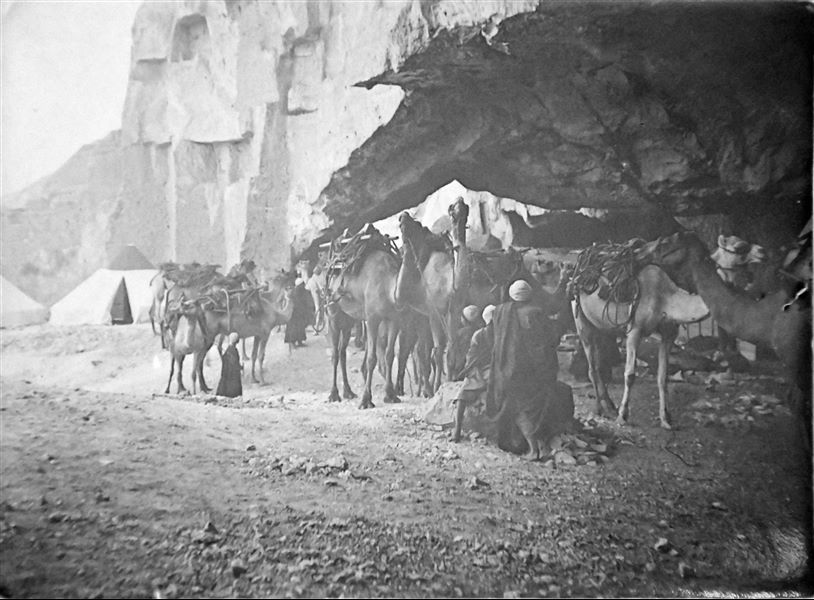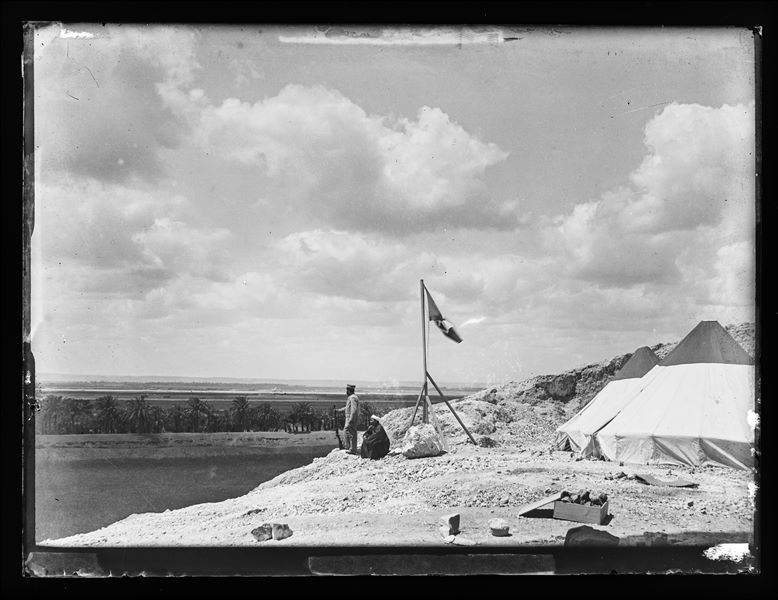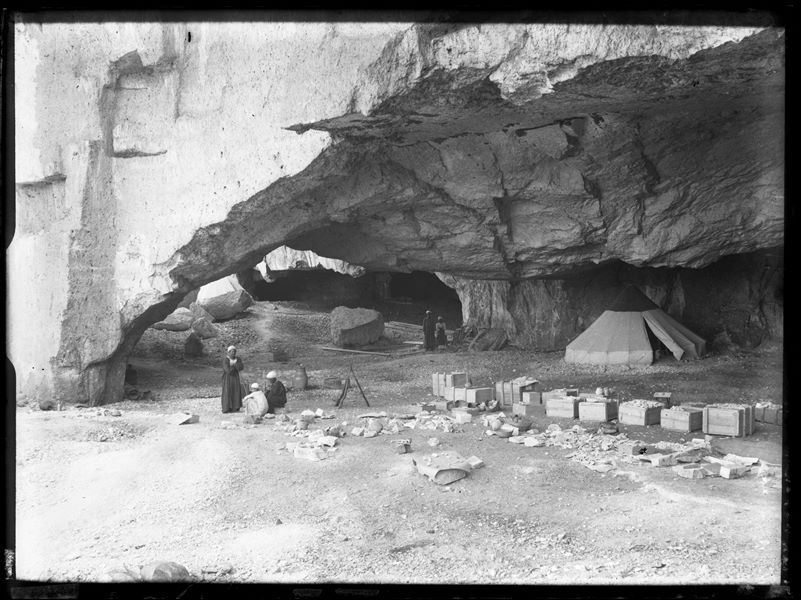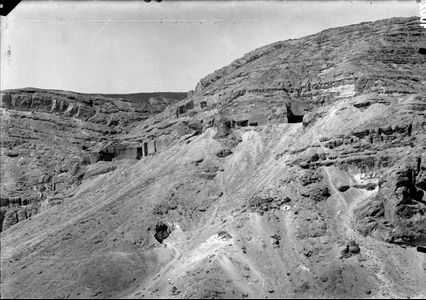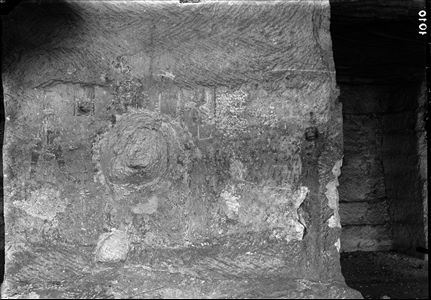Camp of the Italian Archaeological Mission in the stone quarries at Qau el-Kebir. The person seated is Benvenuto Savina; the standing figure however is not recognisable. Schiaparelli excavations.
Camp of the Italian Archaeological Mission near the caves and stone quarries of Qau el-Kebir. The person pictured is Benvenuto Savina. Schiaparelli excavations.
Camp of the Italian Archaeological Mission near the caves of Qau el-Kebir. In the foreground we see Benvenuto Savina and a group of Egyptians; identifiable from the left we see the interpreter and guide Bolos Ghattas (seated), the cook Atallah (standing) with the young assistant Buhus (seated and dressed in light colours). The other two Egyptians are not recognisable. In the background a bridge on a dried-up canal can be seen, presumably the same pictured in B00984. Schiaparelli excavations.
Camp of the Italian Archaeological Mission near the caves of Qau el-Kebir. In this shot, the camels are ready to depart. Visible in the middle, nearing the completion of a crate is the figure of the carpenter of the mission – Morkos, with a drill in his hand. In the background to the left, Benvenuto Savina is visible. The Egyptian workers are not identifiable. Schiaparelli excavations.
Camp of the Italian Archaeological Mission near the caves of Qau el-Kebir. Arrival of camels to begin transporting the cases towards the Nile. Schiaparelli excavations.
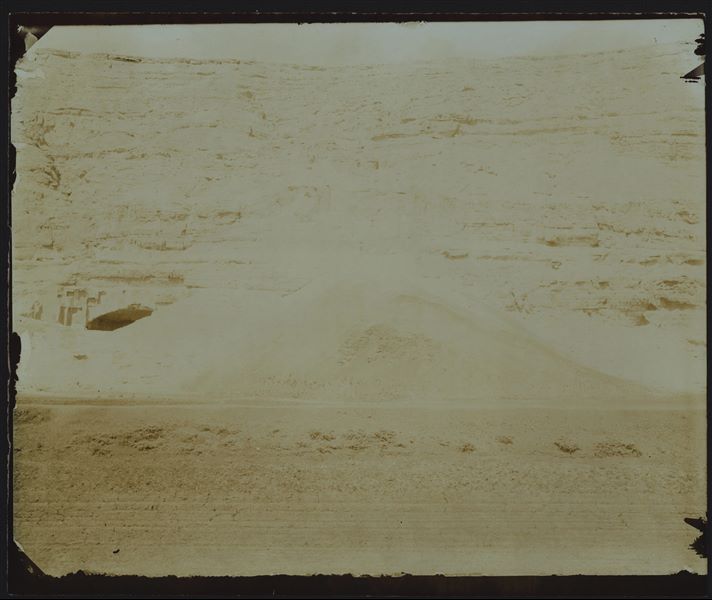
View of the cave in the mountain of Qau, photographed from the plain, used as a camp by the Italian Archaeological Mission. Two conical tents of the mission can be seen near the entrance. Schiaparelli excavations.

View of the cave in the mountain of Qau, photographed from the plain, used as a camp for the Italian Archaeological Mission. In the centre, the flagpole is visible, while to the left; one of the mission's conical tents can be seen. Schiaparelli excavations.
Interior of one of the caves where the Italian Archaeological Mission camped during excavations in the necropoleis of Qau el-Kebir and Hammamiya. In the foreground there are some members of the mission, including the young assistant-cook Buhus dressed in white, the interpreter and guide Bolos Ghattas (in grey), and the mission's “jack of all trades”, Benvenuto Savina, the only one wearing European clothing and holding a rifle. The remaining characters are presumably the cook, Atallah, and the rais (heads of the workers). In addition to the conical tents, crates for transporting the ancient finds and mission material can be seen in the camp. Photo album, Schiaparelli excavations.
Interior of one of the caves where the Italian Archaeological Mission camped during excavations in the necropoleis of Qau el-Kebir and Hammamiya. The only identifiable individual is the figure in the centre wearing western clothing, undoubtedly Benvenuto Savina. In addition to the conical tents, crates for transporting the ancient finds and mission material can be seen in the camp. Photo album, Schiaparelli excavations.
Interior of one of the caves where the Italian Archaeological Mission camped during excavations in the necropoleis of Qau el-Kebir and Hammamiya. The three visible figures are barely recognisable, perhaps the boy dressed in white, due to similarities with other photographs, could be the assistant-cook Buhus, thus suggesting that one of the other two remaining figures is in fact the cook, Atallah. In addition to the conical tents, crates for transporting the ancient finds and mission material can be seen in the camp. Photo album, Schiaparelli excavations.
Italian Archaeological Mission camp near the Qau el-Kebir caves. Benvenuto Savina can be spotted, holding a rifle. Photo album, Schiaparelli excavations.
Francesco Ballerini photographed together with Rais Kalifa (standing) and the young Buhus, in front of the cave that served as a campsite during the Italian Archaeological Mission’s excavations in 1905 and 1906 at Qau el-Kebir and Hammamiya. Angelo Sesana Archive
Francesco Ballerini photographed together with Rais Kalifa (standing) and the young Buhus, in front of the cave that served as a campsite during the Italian Archaeological Mission’s excavations in 1905 and 1906 at Qau el-Kebir and Hammamiya. Angelo Sesana Archive
Photograph of part of the Italian Archaeological Mission’s camp during excavations at Qau el-Kebir and Hammamiya in 1905 and 1906. Identifiable next to the pole with the Italian flag is Benvenuto Savina, the mission's “jack of all trades”. Angelo Sesana Archive.
Italian Archaeological Mission’s camp near Qau el-Kebir. Photograph taken from the cave used as a base camp for the excavations. In the centre-foreground, the rifles supplied to the mission by the Italian Army are visible. Angelo Sesana Archive.
Photograph of the Italian Archaeological Mission’s kitchen in the cave of Qau el-Kebir, where the camp was located. Here, the cook Atallah is preparing some food. Young Buhus, the assistant cook is also present, it appears that he is trying to light the fire. (Original caption: Mission’s kitchen). Angelo Sesana Archive.
Italian Archaeological Mission’s camp in Qau el-Kebir. The photograph shows the carpenter Morkos making crates for the transportation of the materials. Photo taken towards the end of the mission. Angelo Sesana Archive.
Italian Archaeological Mission’s camp in Qau el-Kebir. The photograph shows the landscape that could be viewed from the cave. In the foreground, one of the mission's conical tents. Angelo Sesana Archive.
Italian Archaeological Mission’s camp in Qau el-Kebir. The photograph shows the final excavation stages and getting the crates ready for their transport. Angelo Sesana Archive.
View of the landscape from the Italian mission’s camp at Qau el-Kebir, where a conical tent and three guns are visible. Angelo Sesana Archive.
The Italian Archaeological Mission’s camp, with its typical conical-shaped tents, near Qau el-Kebir. Near the Italian flag, a seated Egyptian and Benvenuto Savina look towards the horizon. In the foreground there is a box with archaeological finds. Schiaparelli excavations.
The Italian Archaeological Mission’s camp in the stone quarries near Qau el-Kebir. Two groups of Egyptian workers are depicted resting or posing (in the background, the carpenter Morkos and an assistant). In the background on the right, near the wall, there is one of the Mission's tents, while in the foreground there are crates containing various archaeological finds. Schiaparelli excavations.
The Italian Archaeological Mission’s camp near the caves of Qau el-Kebir. Next to the tents and the flag, the cook Atallah can be seen standing. Schiaparelli excavations.





